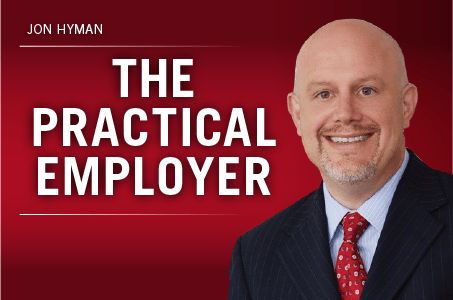A local Subway recently earned itself some bad publicity when an employee denied access to a customer with a service dog.
While this story involved a customer and not an employee, it did get me thinking about employee service dogs at work.
I created this handy FAQ on service dogs at work for your reference.
Q1: What does the ADA say about service animals?
A1: Believe it or not, Title I of the ADA (the part of the law that covers employers and employees) is completely silent on the issue of service dogs. Thus, because Title I does not specifically address service animals, an employer should consider a request from an employee to bring a service animal to work just like any other request for a reasonable accommodation. This means that employers must consider the request, but do not have to automatically allow employees to bring their service animals to work.
Q2: What types of service animals does the ADA cover?
A2: Only two species can ever qualify as service animals under the ADA—dogs and miniature horses. That’s it. Any other animal, even if trained to do work or perform tasks for the benefit of an individual with a disability, is not an animal for which the ADA requires the consideration of an accommodation.
Q3: How should employers process requests for service animals by employees?
A3: Because the ADA is silent on this issue, a request to bring a service animal to work is nothing more than a request by an employee for an employer to modify its no-animals-in-the-workplace policy. If you have such a policy, you must consider modifying the policy on a request-by-request, case-by-case basis. If you don’t have such a policy, and generally allow other employees to bring animals to work, then you should allow employees with disabilities to bring service animals.
Q4: Must an employer allow service animals upon request, or can it offer other accommodations?
A4: A disabled employee is entitled to a reasonable accommodation, not his or her preferred accommodation. Thus, if there exists another reasonable accommodation (other than an exception to your no-animals policy) that will enable the employee to perform the essential functions of his or her job, then you can offer that accommodation in lieu of permitting a service animal. That said, because of the personal nature of a service animal, you should be prepared for the possibility that it might be the only reasonable accommodation in many instances.
Q5: What kind of documentation can an employer seek from an employee in support of the request for a service animal at work?
A5: When an employee with a disability requests the use of a service animal at work, the ADA grants the right to an employer to request medical documentation to support the need for the accommodation (if the need is not otherwise obvious; a blind employee should not need to prove the need for a seeing eye dog). Also, an employer has the right to request proof that the service animal is appropriately trained and will not disrupt the workplace.
Q6: Can you require proof of certifications, vaccinations, or insurance coverage?
A6: I would. Before being permitted to bring animals to work, owners (even those with disabilities and service animals) should verify that vaccinations are up to date, that the animal licensed and free of parasites and insects, and on regularly scheduled flea and tick preventatives. An employee should verify, in writing, sufficient homeowners’ or renters’ insurance to cover any damage to person or property caused by the animal. You could also consider indemnification in case your business gets sued, and a written paycheck deduction authorization for any damage caused (but I wonder if this could creep into the realm of discrimination or retaliation if you don’t require the same of other employees in similar circumstances.)
Q7: Can I hold the animal to certain workplace standards?
A7: Absolutely. I have no issues with requiring that all service animals be “office broken.” Animals with any bite history should not be permitted. Moreover, any aggressive behavior, such as growling, barking, chasing, or biting, should result in the animal’s expulsion on the first complaint. Animals should also be house broken, friendly towards people and other animals, and not protective of their owners or their owners’ spaces. Finally, you should define when animals must be leashed or otherwise restrained.
Q8: Can an employer deny a request if certain areas are off limits, or to accommodation other employees with certain animal allergies or phobias?
A8: No. If certain areas are off limits, for example, because of safety or other reasons, you just set rules and limits keeping the animal out of those areas. It’s not a reason to deny a request outright. Similarly, when you have When you have two people with disabilities, you don’t treat one as more important than the other. Instead, you work out a balance between each’s needs and accommodations.
Q9: How you handle a service animal’s bathroom needs?
A9: Designate a specific area outside for animals to go to the bathroom (preferably away from the entrances), and make sure pet owners understand that it is their responsibility (and only their responsibility) to clean up messes outside and accidents inside. You may, however, have to considering altering an employee’s break time(s), or providing additional breaks, to permit the disabled employee to care for the needs of his or her service animal.
Q10: What about emotional support animals, and other animals not classified as “service” animals?
A10: Emotional support animals, comfort animals, and therapy dogs are not service animals under the ADA. Thus, you have no duty to accommodate these requests.
These are not easy issues to work through. My recommendation is that you work with your employment counsel if you receive an accommodation request for a service animal from an employee.






